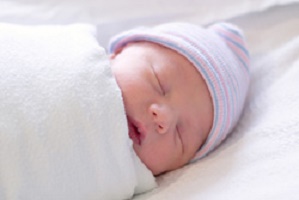 |
The practice of wrapping newborn infants tightly in blankets that restrict movement of their limbs is an ancient one, happening even before Biblical times. Its popularity has ebbed and flowed, but it is still routinely practiced in many hospitals, and is making a comeback among some parents, either in the form of a tight blanket that holds the baby’s arms and legs straight, or a looser form of wrapping that keeps the arms free. There are, increasingly, commercial “baby swaddles” and other swaddling paraphernalia, as well as YouTube videos to teach parents how to swaddle correctly. Swaddling is done for many reasons, including warmth, the prevention of scratching, and to calm crying and fussiness in hospital nurseries and at home. Unfortunately, swaddling seems to conflict with the emotional care that is the basis of attachment parenting and other conscious ways of being with children, in addition to having some physical problems. Here are some reasons not to swaddle your newborn. 1. A baby cries for a reason and the parent’s job is to quickly determine the reason for the cry and solve the problem with milk, attention, pain relief, motion, a dry diaper, a temperature change, or whatever is required – with the priority on fixing the situation, not on stopping the noise. Wrapping an infant up tightly might lessen her crying, but it might also make her feel abandoned and stressed, rather than relaxed and content. 2. Swaddling leads newborns to sleep more and deeper. That will provide a welcome respite for tired parents, but it will also interfere with skin-to-skin bonding, and lessen the frequency of feeding, slowing weight gain and increasing dehydration. 3. Swaddled babies look so warm and cozy. However, they can become dangerously overheated – not only because of the effect of the blanket, but because they can’t wave their arms and legs around to cool themselves off. 4. Babies need skin-to-skin contact. Those who don’t get it feel profound stress. Skin-to-skin contact can also reduce the stress of being born. As well as helping regulate a newborn’s temperature, skin-to-skin contact also helps stabilize his breathing, hormone levels, and heart rate. 5. One purpose of swaddling is to soothe the newborn by reminding her of the womb. However, a fetus has freedom of movement in utero that is not possible when swaddled. Her post-birth freedom to wiggle toes and fingers (and put them in her mouth) and wave arms and legs is part of the developmental process and helps develop both muscle control and the nervous system. Recent studies have shwon that movement helps improve cognitive functioning in people of all ages, and infants are at a stage of rapid cognitive development. They can't explore how their bodies work when swaddled. 6. Swaddling has been implicated in Sudden Infant Death Syndrome (SIDS). (It’s also believed by some that swaddling lowers the risk of SIDS because it prevents a baby from rolling onto his stomach, which has been linked to SIDS, and prevents him from covering his face with a blanket as he squirms.) While a swaddled newborn might stay in the position in which he was laid down, older swaddled babies have been known to flip themselves over and get stuck in the face-down position. Overheating has also been linked to SIDS. 7. Swaddling can contribute to dysplasia of the soft hips of newborns, which can lead to problems with the joint later in life. According to the International Hip Dysplasia Institute, “Sudden straightening of the legs to a standing position can loosen the joints and damage the soft cartilage of the socket.” 8. The risk of upper respiratory infections can be increased by the hampered ability to breathe deeply when infants are tightly swaddled. In one study, published in the American Journal of Public Health, the risk of developing respiratory infections increased fourfold in swaddled infants. One of the swaddlers is advertised in this way: “The first several months of Baby’s arrival can be quite tough on the sturdiest of new parents. The [product] has been proven to greatly extend sleep periods between feedings...allowing Mom and Dad more extended rest, enhanced relaxation, and peace of mind.” I think there are more empathetic ways to soothe our babes. Wendy Priesnitz is the editor of Natural Child Magazine. She is also the editor of Natural Life Magazine and Life Learning Magazine, the author of 13 books, and a journalist with over 40 years experience. She is the mother of two adult daughters.
| |






